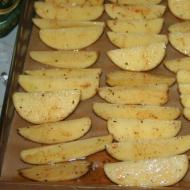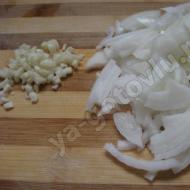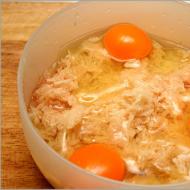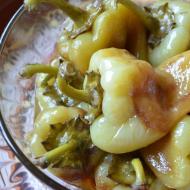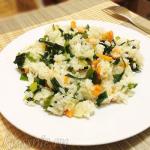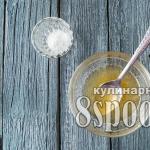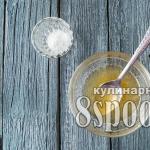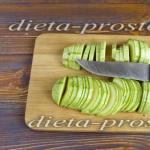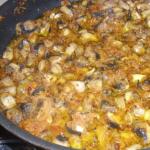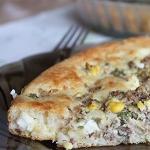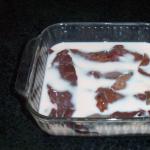
The benefits and harms of the food additive E200 - sorbic acid. Preservative E200 Sorbic acid Harm from sorbic acid to humans
Preservatives based on sorbic acid - sorbic acid itself (E200), potassium sobate (E202) and calcium sorbate (E203) - are successfully used in the production of almost all food products (Table 1), including weakly acid ones. For example, the addition of 0.2% sorbic acid to butter cream allows you to increase the shelf life of cream cakes and pastries at a temperature of 2-8 C from 36 to 120 hours (OST 10-060-95 "Cakes and pastries"); treatment of loaves of semi-smoked sausages with a concentrated solution of potassium sorbate increases the shelf life without mold by 4 times; margarine containing sorbic acid is stored at a temperature of 6-8 C for at least 2 months instead of the usual 20 days (GOST 240-85 "Margarine").
Table 1. Approximate doses of interchangeable preservatives in food products.
| Product | ||
| Butter, margarines | 30-60 | |
| Butter, margarines | - | 60-120 |
| Mayonnaise, mustard, ketchup | - | 100-200 |
| cheeses | 60-100 | - |
| fish products | 100-200 | - |
| Meat meats, smoked sausages | 200-400 | 200-400 |
| Boiled sausage | 50-80 | - |
| Canned vegetables | - | 100-200 |
| Sauerkraut | - | |
| Tomato puree, 12% | - | 50-150 |
| Jams, preserves, marmalade, etc. | 50-150 | 70-200 |
| Fruit and berry puree | 50-60 | 50-60 |
| Fruit fillings for baking | - | 150-200 |
| Fruit preparations for yogurt and other dairy products | - | 100-150 |
| Apple juice semi-finished product | ||
| Grape juice - semi-finished product | 50-60 | 65-80 |
| Fruit juice concentrates | - | 100-200 |
| Soft drinks | - | 40-60 |
| Carbonated soft drinks | - | 30-40 |
| Herbal infusions, tea coffee | - | 40-60 |
| Low alcohol wines | - | 20-30 |
| Non-alcoholic wines | - | |
| Sugar confectionery (sweets, waffle fillings, nougat, pralines, chocolate) | 80-50 | 150-200 |
| Flour confectionery (yeast-free) | 100-200 | 130-200 |
| Semi-finished confectionery products (dough) | 200-300 | - |
| Butter cream | ||
| Bread and bakery products | 150-200 | - |
* joint use of sorbic acid and potassium sorbate;
* grams per 100 kg of minced meat;
* grams per 100 liters of brine;
* grams per 100 kg of flour (Panosorb is used)
There are special forms of preservatives based on sorbic acid (Panosorb) and potassium sorbate (Vinosorb) used in order to avoid undesirable technological effects in the preservation of bakery products and wines, respectively.
Panosorb is a preservative for bakery products. Panosorb is a special form of sorbic acid that dissolves slowly during dough preparation without affecting fermentation.
Panosorb prevents the development of microorganisms during the storage of bakery and baked goods (slows down molding), without inhibiting the action of baker's yeast during fermentation and proofing.
Recommended applications: any yeast baked goods. Bakery, lamb, rich, puff, crackers, etc. Dosage: 0.15-0.2% by weight of the product. Dosage for pan breads from premium flour from 0.1-0.2% of the product weight. Dosage for puff pastry is 0.1% by weight of the product. Dosage for rye dough 0.2% of product weight. Changing the dosage does not affect either the proofing process or the baking process.
Mode of application: the calculated amount of Panosorb in the case of the double and non-steam method of production is added to the dough along with flour. When periodically preparing the dough, it is recommended to pre-mix Panosorb with a small amount of flour used for kneading, then add it to the remaining flour, mix and use it when kneading. With continuous dough preparation, Panosorb is fed along with the flour used for kneading the dough.
| Vinosorb new |
To prevent secondary fermentation during cold sterile bottling
Product description
Organoleptically neutral, pearly white special product for wine stabilization. Potassium sorbate E 202. For foodstuffs (limited use): any use must be carried out in accordance with the normatively accepted maximum dosage of 270 mg of Vinosorb new product per 1 liter. Vinosorb the new one is a potassium salt of sorbic acid, a low molecular weight fatty acid. These fatty acids are found in natural foods. Potassium sorbate is also used as a harmless preservative in a number of foods.
The product has been approved for use in accordance with current legal regulations.
Purity and quality are guaranteed by specialized laboratories.
Purpose of processing
Prevention of secondary fermentation in the bottle. Inhibitory effect on yeasts and molds (not on bacteria).
The product and its action
In the process of bottling, Vinosorb new protects against yeast and fungi for a long time. For this purpose Vinosorb new has been successfully used for many years in 35 countries where viticulture is developing - to prevent secondary fermentation in the bottle. In principle, this product is effective only against fungi and yeast, not against bacteria. Therefore, he cannot cancel the standard sulfitation step, which simultaneously has a bactericidal and antioxidant effect. 134 mg of potassium sorbate is equivalent to 100 mg of sorbic acid.
Application
The recommended and maximum allowed dosage is 27 g of the product per 100 liters, i.e. 270 mg / 1 l of the final product. A solution of Vinosorb new is added directly to the tank, with mandatory mixing for thorough distribution. It is not recommended to pre-dissolve the drug in a small amount of wine. Vinosorb is preferable to add directly to the tank when blending. In this case, it is necessary to strictly calibrate the content of free SO2, which must be constant at the desired concentration. In wine, the constant content of free SO2 must be at least 40 mg/l. The addition of new Winsorb should be done, if possible, 24 hours before bottling, to ensure uniform distribution in the wine.
Storage
Protect from moisture and foreign odors. Seal opened packages immediately and tightly.
Sorbic acid preservatives are effective against yeasts, molds and some bacteria in almost all types of food products, but their spectrum of antimicrobial activity is still limited. Therefore, in a number of products it is recommended to combine them with other preservatives. Particularly effective is the joint use of potassium sorbate with sodium benzoate (in soft drinks, ketchup, mayonnaise, fish products, vegetable and fruit preservatives). An additional addition of nisin (a substance that suppresses bacteria resistant to sorbic acid) to processed cheeses and canned food is also used.
Sorbic acid is a colorless granule, similar to sugar, which has an average degree of solubility in water. For the first time this substance was discovered in the late fifties in the juice of mountain ash. The name comes from the Latin word Sorbus, which means mountain ash. Since that time, the production of the preservative sorbic acid on an industrial scale began.
Sorbic acid e200 has the following properties:
- inhibitory effect on mold fungi, yeast, bacteria of some species;
- absence of microbicidal effect, which implies the use only for pure products;
- no impact on the organoleptic properties of food products;
- slowing down the development of microorganisms, which increases the shelf life.
The use of sorbic acid
Sorbic acid is used as an additive in the food industry. It is used as a natural preservative aimed at increasing the shelf life due to its antimicrobial properties in such foods: bakery, confectionery, sausages, canned fish, meat, vegetable, alcoholic and non-alcoholic drinks, dairy products, coffee, juices, cocoa and etc. As a preservative, it prevents the development of mold, yeast, and other pathogens. The substance is also used for the purpose of processing containers, dissimilar materials for packaging. In meat products - as a substance that prevents the action of the causative agent of botulism, that is, reduces the amount of nitrites.
Sorbic acid e200 is widely used to preserve various fruits, confectionery and egg products, fish and meat products, soft drinks, juices from berries and fruits. The main products in which this additive can be found are: granular caviar, bakery products, drinks, juices, sausages, sweets, condensed milk.
During the manufacture of minced meat, up to one tenth of a percent of the preservative is added to the mass of minced meat. For hard sausage, the amount is up to four tenths of a percent. Raw chicken carcasses are sprayed with a hot preservative solution to increase the shelf life of up to four weeks.
In canned fish and products, up to four percent of sorbic acid e200 is added to the total mass of salt for salted fish, and for canned products - up to eight hundredths of a percent to the mass of the fish itself.
For baking, up to fifteen hundredths of a percent of acid is added when kneading the dough. In order to increase the shelf life of the cream and oil, two tenths of a percent are added to the mass of the entire cream.
Sorbic acid is added to margarine as a preservative to protect against bacterial decomposition of fats, mold, and saponification. 0.08-0.15% is added to sauces, ketchups and mayonnaises.
As shown by numerous experiments, there are no carcinogens in sorbic acid e200. This is the main argument in favor of the introduction of additives in food. The permissible content of the substance in the products is not more than 0.2%. In the food industry, it can be used both separately and in combination with other preservatives.
The effect of sorbic acid on the body
Due to the antibacterial properties due to the chemical composition, sorbic acid has a positive effect on the human body:
- fights harmful microorganisms, plays the role of an antiseptic;
- promotes the elimination of toxins from the body;
- boosts immunity.
Despite the low toxicity, sorbic acid requires compliance with the dosage. The daily rate should not exceed 25 mg per kilogram of adult weight. In case of higher doses, irritation in the form of a rash and destruction of vitamin B12 may occur.
The harm of sorbic acid
In addition to useful properties, the harm of sorbic acid to human health has been identified. The chemical composition of the additive is characterized by the presence of elements that can provoke the appearance of persistent and severe allergic reactions. Do not exceed the allowable dose for an adult.
Popular Articles Read more articles
 02.12.2013
02.12.2013
We all walk a lot during the day. Even if we have a sedentary lifestyle, we still walk - because we don't have...
611387 65 Read more
 10.10.2013
10.10.2013
Fifty years for the fair sex is a kind of milestone, after stepping over which every second ...
453353 117 Read more
 02.12.2013
02.12.2013
In our time, running no longer causes a lot of rave reviews, as it was thirty years ago. Then society would...
Sorbic acid is used to protect certain food products from microbiological spoilage. Suppressing the development of microorganisms, it does not change the taste and smell of products, is not toxic to humans; has a detrimental effect on the microflora in dosages lower than other chemical preservatives (for example, sodium benzoate). These properties are very valuable and give sorbic acid great advantages over other preservatives: sulfur dioxide, sodium benzoate, salicylic and propionic acids, which give food products specific unpleasant odors and tastes.
Sorbic acid at a concentration of up to 0.1% inhibits the reproduction of widespread bacteria, including E. coli, yeast and fungi. Microorganisms such as Staphylococcus aureus are affected by sorbic acid at a concentration of 0.1% or more.
In the confectionery industry, special requirements are imposed on preservatives, since confectionery products easily perceive foreign smells and tastes. The preservative added to the confectionery must have a neutral taste and odor. Such requirements are met by sorbic acid and its salts (sorbates).
Abroad, to protect cakes from molding, sorbic acid is used in an amount of 0.1% by weight of the product and potassium sorbate in an amount of 0.12%. At the same time, the shelf life of cupcakes increases from 12 - 17 to 19 - 38 days. Sorbic acid is 2.5 times more effective than propionic acid and 4 times sodium propionate, moreover, the latter change the taste of products.
To protect marzipans, nougat, waffle fillings, pralines, chocolate, cookies, fruit pastes and jelly fillings from spoilage, 0.08 - 0.1% sorbic acid is added to these products. Sorbic acid is added at the end of the boil, and in some cases a preservative is added with sugar or powdered sugar. When preserving products with a high moisture content, potassium sorbate is used in the form of mixtures with aromatic substances to reduce the consumption of sorbic acid. The shelf life of marmalade is increased by treating the surface with potassium sorbate solutions or wrapping products with paper enriched with calcium sorbate. The product is stored for 4 months without mold.
The preservative effect of sorbic acid on custard to suppress the vital activity of Staphylococcus aureus and Escherichia coli was investigated by E. A. Sherbova, V. S. Gruner and F. M. Chistyakov. Sorbic acid was dissolved in water and the solution was used to make custard. The finished cream was artificially infected with microorganisms in the amount of 250 thousand cells per 1 g of cream and thermostated at a temperature of 37 "C. The authors suggest using sorbic acid in an amount of 0.2% by weight of the cream. This dosage of preservative reduces the number of Staphylococcus aureus bacteria to 45 thousand. cells after 24 hours of incubation and 23.7 thousand cells after 72 hours. The control sample of the cream contained 667 million cells after 27 hours of incubation and 1 billion 20 million cells after 48 hours.
The possibility of using peasant butter and concentrated cream for the manufacture of high-quality Charlotte cream makes the issue of microbiological stability of butter cream especially important, since such cream has a high moisture content (28 - 30%) compared to cream obtained from butter with 16% - nym moisture content (25 - 27%).
Sorbic acid has been used to improve the microbiological stability of Charlotte Cream. Its effect in various dosages on the microflora (Staphylococcus aureus and Escherichia coli) of a cream made from peasant oil was studied.
The following dosages of sorbic acid were used to preserve the cream: 0.075; 0.1; 0.12; 0.15; 0.175; 0.2% by weight of the cream. Sorbic acid in crystalline form was introduced into a syrup having a temperature of 80°C, dissolved in it, and then the syrup was used to make a cream.
Cream samples were infected with cultures of Staphylococcus aureus and Escherichia coli, the vital activity of these microorganisms was studied during the storage of the cream after 3, 24, 48, 72, 96 and 120 hours. - 75%.
Different amounts of microbial bodies of Staphylococcus aureus and Escherichia coli (from 1000 to 2 million per 1 g of cream) were separately introduced into the samples of the original cream in order to monitor their vital activity depending on the contamination. In each sample, after the expiration of the above storage periods, the number of microbial bodies was determined. Since the purpose of conservation is to stop the reproduction of microorganisms, they were quantified.
The vital activity of microorganisms is expressed by a coefficient showing the ratio of the number of microorganisms found in 1 g of cream to their initial number. The vital activity coefficient of microorganisms K was calculated by the formula K = a/b, where a is the number of microorganisms found in 1 g of cream; b - the initial number of microorganisms introduced into 1 g of cream.
The values of the coefficient of vital activity of microorganisms less than 1 indicate the cessation of reproduction of bacteria and their death.
Microbiological studies of peasant oil showed a low titer of Escherichia coli, which amounted to 0.001 g (the titer is the smallest amount of a product in which one bacterial cell was found). For comparison, samples of butter with a moisture content of 16% were studied, the titer of E. coli is 0.3 - 0.4 g. This indicates that peasant butter is more susceptible to microbiological deterioration than butter with a moisture content of 16% . No pathogenic microorganisms were found in peasant oil.
Cream "Charlotte" on peasant butter contained 27 - 28% moisture. The cream without the introduction of a preservative and infection with microorganisms was examined for the content of pathogenic microflora and determination of coli-titer. The coli-titer for this cream was 0.002 g, no pathogenic microflora was found.
With the introduction of a culture of Staphylococcus aureus into the prepared cream, an intensive reproduction of this type of bacteria during the storage of the cream was found.
On fig. 32 shows curves characterizing the change in the vital activity of Staphylococcus aureus bacteria during the storage of the cream with an initial content of microorganisms in the amount of 2300 and 2 million microbial bodies per 1 g of cream. The vital activity coefficient of Staphylococcus aureus slightly increases in the first 48 hours of storage and increases sharply with further storage of the cream for 120 hours, reaching values of 122 and 315. A large increase in the vital activity coefficient of Staphylococcus aureus was noted for a cream with a greater contamination by microorganisms.
The vital activity coefficient of Escherichia coli bacteria for this cream was 1.42 after 24 hours of storage and 26.5 after 120 hours of storage of the cream with an initial content of microorganisms of 2.26 million per 1 g of cream.
The data obtained indicate a less intensive reproduction of E. coli bacteria compared with Staphylococcus aureus bacteria in a cream made from peasant butter.
Further, the intensity of reproduction of Staphylococcus aureus and Escherichia coli bacteria was studied using various dosages of sorbic acid. We studied the vital activity of Staphylococcus aureus bacteria during storage of a cream prepared with sorbic acid, with an initial content of microorganisms in the amount of 1000–1200 microbial bodies per 1 g of cream.
As can be seen from fig. 33a (curves 1, 2), when using sorbic acid in an amount of 0.12 and 0.15% by weight of the cream, the multiplication of Staphylococcus aureus bacteria was observed within 3 hours after the preparation of the cream, the vital activity coefficient increased to 1.36 - 2, 0. Storing the cream for 48 hours led to some decrease in the reproduction of Staphylococcus aureus bacteria, but then their vital activity increased again. After 120 hours of storage of the cream, the vital activity coefficient of Staphylococcus aureus bacteria was 1.2 - 1.36.

Rice. 33. Vital activity of Staphylococcus aureus and Escherichia coli bacteria in a cream obtained from peasant oil: a - culture of Staphylococcus aureus, 1000 - 1200 cells are contained in 1 g of the original cream, the dosage of sorbic acid (in% by weight of the cream): 1 - 0.12; 2 - 0.15; 3 - 0.175; b - a culture of Staphylococcus aureus, 1 g of the original cream contains 200 - 300 thousand cells, the dosage of sorbic acid (in% by weight of the cream); 1 - 0.1; 2 - 0.12; 3 - 0.175; 4 - 0.20; c - culture of Escherichia coli, 1 g of the original cream contains 1.5 - 2 million cells, the dosage of sorbic acid (in% by weight of the cream): 1 - 0.07; 2 - 0.10; 3 - 0.12; 4 - 0.15.
The indicated amounts of sorbic acid are apparently insufficient to stop the reproduction of Staphylococcus aureus bacteria for 3 hours. During the storage of the cream, sorbic acid has a detrimental effect on some microorganisms, their total number decreases. Some microorganisms continue to multiply, which leads to a repeated increase in the vital activity factor. Similar data were obtained when a larger number of microorganisms were introduced into the cream (200 - 300 thousand microbial bodies per 1 g of cream, Fig. 33, b, curves 1, 2).
With an increase in the dosage of sorbic acid to 0.175% by weight of the cream (see Fig. 33, a, curve 3) after 3 hours of storage of the cream (with the introduction of 1200 microbial bodies of Staphylococcus aureus into 1 g of cream), the number of microorganisms did not change. In the process of further storage of the cream, the reproduction of Staphylococcus aureus stops; the vital activity coefficient of Staphylococcus aureus bacteria after 72 hours of storage was 0.24, after 96 hours of storage it slightly increased (0.41), but did not exceed 1.
The introduction of sorbic acid in an amount of 0.175% by weight of the cream with a higher content of bacteria (see Fig. 33, b, curve 3) showed a decrease in the vital activity of Staphylococcus aureus bacteria in the first 3 hours of cream storage and later. A slight increase in the vital activity coefficient of Staphylococcus aureus bacteria was observed, but the latter did not exceed 1. An increase in the dosage of sorbic acid to 0.2% by weight of the cream (see Fig. 33, b, curve 4) led to similar results.
Thus, to stop the reproduction of Staphylococcus aureus in a cream made from peasant butter, the dosage of sorbic acid in the amount of 0.175% by weight of the cream can be considered optimal.
The curves shown in Figs. 33, c, characterize the vital activity of Escherichia coli bacteria in a cream prepared with the addition of sorbic acid, depending on the duration of storage of the cream with an initial content of microorganisms in 1 g of cream in the amount of 1.5 - 2 million microbial bodies. The minimum dosage of sorbic acid (0.07%) led to a decrease in the vital activity coefficient of Escherichia coli bacteria after 3 hours of cream storage to 0.98. With the subsequent storage of the cream up to 120 hours, a continuous decrease in the vital activity coefficient of Escherichia coli bacteria was observed.
An increase in the dosage of sorbic acid (0.10; 0.12; 0.15% by weight of the cream) led to a more noticeable decrease in the reproduction of E. coli bacteria. Thus, at a dosage of 0.10% of sorbic acid to the weight of the cream, after 3 hours of storage, the vital sticks was 0.76, at a dosage of 0.12% - 0.52 and at a dosage of 0.15% - 0.12.
An increase in the duration of storage of the cream led to a further decrease in the vital activity coefficient of Escherichia coli bacteria, which after 120 hours of storage of the cream amounted to 0 - 0.0067.
When using sorbic acid in an amount of 0.175 and 0.2% by weight of the cream, the number of microbial bodies of Escherichia coli added to 1 g of cream was increased to 2,780,000. 0.18 - 0.21, and after 72 hours - 0.14 - 0.018. Therefore, to stop the reproduction of E. coli bacteria, it is enough to introduce sorbic acid into the cream in an amount of 0.1% by weight of the cream.
When studying the effect of sorbic acid on the vital activity of Staphylococcus aureus and Escherichia coli bacteria in a cream prepared from butter with a moisture content of 16%, results similar to those described above were obtained.
Thus, sorbic acid can be used as a preservative for Charlotte Buttercream. The optimal dosage of sorbic acid, which stops the reproduction of Staphylococcus aureus and Escherichia coli bacteria, is 0.175% by weight of the cream.
The use of sorbic acid as a preservative for Charlotte cream in the indicated dosage was approved by the Chief Sanitary Doctor.
A technological instruction on the use of sorbic acid as a butter cream preservative was developed and approved by the Confectionery Industry Administration, according to which sorbic acid is introduced into Charlotte syrup in an amount of 0.3% by weight of the syrup (300 g per 100 kg of syrup). Charlotte syrup is prepared in accordance with the technological instructions for the production of semi-finished products for cakes and pastries. Sorbic acid is dissolved in a small amount of hot (80 "C) syrup, introduced into Charlotte syrup and thoroughly mixed. Charlotte cream is prepared in accordance with the technological instructions for the production of butter cream.
It is difficult to imagine the modern food industry without the use of additives. These include sorbic acid, the benefits and harms of which have been carefully studied by experts. When used correctly, the additive will greatly simplify the work with dishes and preparations that need long-term storage. However, the abuse of sorbic acid can adversely affect the state of the body.
Sorbic acid - description and characteristics of the substance
Initially, sorbic acid was a natural preservative, which was extracted from rowan juice. With the growth of industrial appetites, the additive began to be synthesized artificially, which affected its physical and chemical properties, but made it possible to reduce its cost.
Sorbic acid crystals are small, colorless and odorless. The substance is not a carcinogen and does not have toxic properties. It is slightly soluble in water and has many properties. Sorbic acid is used in various industries, but is best known as a food additive, which in the international classification received the designation E200.
Advice
Sorbic acid only slows down the development of pathogenic microorganisms, and does not destroy them. Therefore, it is pointless to try to use the additive to restore already spoiled products. Their quality from the presence of a chemical reagent will not improve.
The main effect of sorbic acid, for which the additive is valued by food manufacturers, is the inhibition of the development of pathogenic microflora, mainly bacteria and fungi. At the same time, beneficial microorganisms (even those that are in the intestines) do not suffer, the properties of dishes, semi-finished products and ingredients do not change. As a result, the shelf life of products is significantly increased.

The benefits of sorbic acid
The beneficial properties that a food additive has are based on the mechanism of its action. E200 does not create a sterile environment, retaining the capabilities of bacteria that have a beneficial effect on the human body. If you consume the supplement in small quantities, you can even count on additional positive effects:
- Strengthening immunity, which is especially pronounced in people with weakened protection against infections and adverse external factors.
- The E200 supplement accelerates the elimination of poisons and toxins from the body by stimulating the work of the intestines.
- Suppression of pathogenic microflora in the intestine, inhibition of the development of pathological processes.
Of course, such results should be expected only if the sorbic acid used is natural or as purified as possible. There is another important point - in the stomach of a healthy person or with increased acidity, the additive will be neutralized. After that, the products of its decay will leave the body naturally.

What is the danger of sorbic acid?
The debate about whether the E200 supplement is harmful continues, but scientists still managed to establish the basic facts. You can only be poisoned by a substance if you use it in its pure form. Even if the body receives 25 mg of sorbic acid per kilogram of body weight, this will not exceed the permissible norm. However, in such volumes, E200 is not added anywhere. At the same time, sorbic acid is completely and without delay removed from the human body, without settling or accumulating in the tissues.
People with a tendency to food allergies are generally not recommended to eat food with food additives. According to the observations of scientists, E200 can provoke an allergy in the form of a rash and swelling, but today the number of such cases is extremely small.

Nevertheless, there is a feature due to which sorbic acid can be classified as a substance that adversely affects human health. It contributes to the active destruction of vitamin B12, which is involved in many important chemical processes. Because of this, people who constantly use products with the addition of E200 may suffer from nervous disorders caused by the rapid death of nerve cells. Because of this feature, in a number of countries sorbic acid is included in the list of banned substances.
Applications of sorbic acid
The scope of the food additive is quite extensive. Initially, sorbic acid was added even to medicines, but later this practice was abandoned. Today, the component can be found in sauces, canned food, pastries, jams, semi-finished products, soft drinks. Increasingly, E200 is added to hard meats, sausages, dumplings and dumplings, confectionery, wines.

According to the existing standard, 100 kg of food products should contain no more than 250 g of sorbic acid. Unfortunately, in order to extend the shelf life, some manufacturers neglect this limitation. Good in such products for the body is not enough. The buyer should be alerted if the buns retain their original appearance for 2-3 weeks, compote and juice do not sour for 10-15 days after opening the package.
Sorbic acid harm and benefit
Sorbic acid - the benefits and harms of food additives
It is difficult to imagine the modern food industry without the use of additives. These include sorbic acid, the benefits and harms of which have been carefully studied by experts. When used correctly, the additive will greatly simplify the work with dishes and preparations that need long-term storage. However, the abuse of sorbic acid can adversely affect the state of the body.
Sorbic acid - description and characteristics of the substance
Initially, sorbic acid was a natural preservative, which was extracted from rowan juice. With the growth of industrial appetites, the additive began to be synthesized artificially, which affected its physical and chemical properties, but made it possible to reduce its cost.
Sorbic acid crystals are small, colorless and odorless. The substance is not a carcinogen and does not have toxic properties. It is slightly soluble in water and has many properties. Sorbic acid is used in various industries, but is best known as a food additive, which in the international classification received the designation E200.
Council Sorbic acid only slows down the development of pathogenic microorganisms, and does not destroy them. Therefore, it is pointless to try to use the additive to restore already spoiled products. Their quality from the presence of a chemical reagent will not improve.
The main effect of sorbic acid, for which the additive is valued by food manufacturers, is the inhibition of the development of pathogenic microflora, mainly bacteria and fungi. At the same time, beneficial microorganisms (even those that are in the intestines) do not suffer, the properties of dishes, semi-finished products and ingredients do not change. As a result, the shelf life of products is significantly increased.

The benefits of sorbic acid
The beneficial properties that a food additive has are based on the mechanism of its action. E200 does not create a sterile environment, retaining the capabilities of bacteria that have a beneficial effect on the human body. If you consume the supplement in small quantities, you can even count on additional positive effects:
- Strengthening immunity, which is especially pronounced in people with weakened protection against infections and adverse external factors.
- The E200 supplement accelerates the elimination of poisons and toxins from the body by stimulating the work of the intestines.
- Suppression of pathogenic microflora in the intestine, inhibition of the development of pathological processes.
Of course, such results should be expected only if the sorbic acid used is natural or as purified as possible. There is another important point - in the stomach of a healthy person or with increased acidity, the additive will be neutralized. After that, the products of its decay will leave the body naturally.

What is the danger of sorbic acid?
The debate about whether the E200 supplement is harmful continues, but scientists still managed to establish the basic facts. You can only be poisoned by a substance if you use it in its pure form. Even if the body receives 25 mg of sorbic acid per kilogram of body weight, this will not exceed the permissible norm. However, in such volumes, E200 is not added anywhere. At the same time, sorbic acid is completely and without delay removed from the human body, without settling or accumulating in the tissues.
People with a tendency to food allergies are generally not recommended to eat food with food additives. According to the observations of scientists, E200 can provoke an allergy in the form of a rash and swelling, but today the number of such cases is extremely small.

Nevertheless, there is a feature due to which sorbic acid can be classified as a substance that adversely affects human health. It contributes to the active destruction of vitamin B12, which is involved in many important chemical processes. Because of this, people who constantly use products with the addition of E200 may suffer from nervous disorders caused by the rapid death of nerve cells. Because of this feature, in a number of countries sorbic acid is included in the list of banned substances.
Applications of sorbic acid
The scope of the food additive is quite extensive. Initially, sorbic acid was added even to medicines, but later this practice was abandoned. Today, the component can be found in sauces, canned food, chocolate, pastries, jams, semi-finished products, soft drinks. Increasingly, E200 is added to hard cheeses, sausages, dumplings and dumplings, confectionery, wines.

According to the existing standard, 100 kg of food products should contain no more than 250 g of sorbic acid. Unfortunately, in order to extend the shelf life, some manufacturers neglect this limitation. Good in such products for the body is not enough. The buyer should be alerted if the buns retain their original appearance for 2-3 weeks, compote and juice do not sour for 10-15 days after opening the package.
www.polzateevo.ru
Sorbic acid - harm and benefit

Specialists in the chemical industry characterize sorbic acid as "a solid, colorless and odorless, poorly soluble in water, and has a distinct sour taste." Ordinary inhabitants can meet with it daily: acid is used as a preservative, so it is labeled as E200 on food packaging. Scientists, in turn, do not give a specific answer to the question: does sorbic acid harm or benefit the human body?
What is sorbic acid E200?
As mentioned above, E200 is a powerful preservative with antibacterial properties. But, unlike many of its "brothers", it only slows down the growth of microorganisms in products. That is why products can retain their "freshness" and "attractiveness" for the consumer for a long period of time. Accordingly, experts note that products with the E200 preservative are not “sterile”, since groups of bacteria live and multiply in them: beneficial and harmful to the human body.
As a dietary supplement, sorbic acid in a minimal amount can even have a beneficial effect on the human body. It strengthens the immune system and also helps to eliminate toxins. E200 can show its antibacterial properties only in a low-acid environment. Therefore, getting into the stomach, the preservative is quickly neutralized by gastric juice and naturally excreted without accumulating in the tissues of the body.
The harm of sorbic acid
Thanks to scientific research, the maximum allowable concentration of sorbic acid in the human body was derived: 25 mg per 1 kg of human body weight. Therefore, this proportion indicates that the E200 preservative can be poisoned only if it is eaten in its pure form.
Scientists authoritatively state that this acid is not a carcinogen, but can cause severe swelling and skin rashes in allergy sufferers. Sorbic acid (E200) causes more harm to a person by completely destroying vitamin B12, which is necessary for the normal course of important physiological processes:
- the formation of normal-shaped erythrocytes;
- participates in the process of regeneration of organs (liver, kidneys, spleen, heart) and tissues;
- the formation of the myelin sheath of nerve tissue.
Thus, people who consume foods high in E200 are more likely than others to suffer from diseases of the nervous system.
Related articles:
| Matcha tea - benefits and harms Most often, Europeans, starting a conversation about Japanese tea, have in mind green tea of the highest grade. There are few varieties of Japanese tea, but each of them is valuable in its own way. This article is about matcha tea. | How useful is rhubarb for the body? From this article you will learn how rhubarb is useful for the human body, as well as the valuable properties of this plant. We will also talk about how rhubarb is useful for the female body in general and for women during pregnancy. |
| The blackberry or "black berry" is a distant relative of the raspberry. It is completely undeservedly rejected by gardeners, although due to its healing properties, blackberries can be considered a "panacea for all diseases." | Pumpkin is a large beautiful orange vegetable, common on all continents of our planet. What is its popularity and benefit? You will learn about this from our article. |
womanadvice.ru
Where is sorbic acid used and what is the harm from it? Preservative E200:
Often on the labels of products, cosmetics or medicines that we buy in supermarkets and pharmacies, you can see the mysterious inscription "sorbic acid" (E200). As a rule, the presence of any extraneous additives in the product is alarming. But is everything so clear? Sorbic acid is a preservative that is widely used in the food, pharmaceutical and cosmetic industries. Such a demand for this chemical compound is due to its strong antimicrobial effects, which prevent premature spoilage of products.
Physical properties of sorbic acid
 According to the description, sorbic acid is a white crystalline powder with a slight specific odor, it practically does not dissolve in water without heating, it dissolves well in organic and mineral acids, and has a slight sour taste.
According to the description, sorbic acid is a white crystalline powder with a slight specific odor, it practically does not dissolve in water without heating, it dissolves well in organic and mineral acids, and has a slight sour taste.
Discovery history
 For the first time, this substance was obtained in the middle of the nineteenth century during the distillation of rowan juice by the German chemist August Hoffmann. However, at the moment this compound is produced on an industrial scale exclusively from non-natural components by chemical synthesis, but this does not affect its quality in any way. For the first time, a synthetic production method was tested at the beginning of the twentieth century. Subsequently, the disinfecting properties of sorbic acid were established and, already in the twentieth century, it began to be actively used, especially in the food industry.
For the first time, this substance was obtained in the middle of the nineteenth century during the distillation of rowan juice by the German chemist August Hoffmann. However, at the moment this compound is produced on an industrial scale exclusively from non-natural components by chemical synthesis, but this does not affect its quality in any way. For the first time, a synthetic production method was tested at the beginning of the twentieth century. Subsequently, the disinfecting properties of sorbic acid were established and, already in the twentieth century, it began to be actively used, especially in the food industry.
Safe synthetic preservative - sorbic acid
 Without exception, all preservatives are covered with the notoriety of potential carcinogens, mutagens, etc. In this case, the fault is the lack of information among the average layman. The fact is that even ordinary table salt, vinegar, honey are natural preservatives and have been used by people for a long time to prevent food from spoiling, because in those days they did not even think about refrigerators! At the moment, when the world's population has increased significantly, as well as its food needs, manufacturers are forced to resort to the help of modern developments in the field of chemistry in order to extend the shelf life of products for a long time.
Without exception, all preservatives are covered with the notoriety of potential carcinogens, mutagens, etc. In this case, the fault is the lack of information among the average layman. The fact is that even ordinary table salt, vinegar, honey are natural preservatives and have been used by people for a long time to prevent food from spoiling, because in those days they did not even think about refrigerators! At the moment, when the world's population has increased significantly, as well as its food needs, manufacturers are forced to resort to the help of modern developments in the field of chemistry in order to extend the shelf life of products for a long time.
It is absolutely wrong that natural substances are considered extremely safe - just remember the fact that the most powerful poisons are of plant or animal origin. Modern manufacturers strive to use quality preservatives that are effective even when used in minimal quantities. These include sorbic acid, because it meets all the requirements that apply to products of this kind. So, this substance does not violate the taste of the product, does not enter into chemical interaction with packaging materials and, of course, is practically harmless to the human body. Although it was first used on an industrial scale in the middle of the twentieth century, sorbic acid has not lost its relevance to this day.
Application
 So, most often sorbic acid is used in the production of bakery products, margarine, in the confectionery industry, in the production of canned fish, meat, dairy products, condensed milk, sausages, hard cheeses, juices, nectars, dried fruits, in various jams and compotes industrial production. Such an extensive area of use is associated with the ability of sorbic acid to inhibit the reproduction of mold, which leads to premature spoilage of products. It is important to note that this preservative blocks the division of microorganisms, while not completely destroying them, so manufacturers try to use sorbic acid in the absence of microorganisms in the product.
So, most often sorbic acid is used in the production of bakery products, margarine, in the confectionery industry, in the production of canned fish, meat, dairy products, condensed milk, sausages, hard cheeses, juices, nectars, dried fruits, in various jams and compotes industrial production. Such an extensive area of use is associated with the ability of sorbic acid to inhibit the reproduction of mold, which leads to premature spoilage of products. It is important to note that this preservative blocks the division of microorganisms, while not completely destroying them, so manufacturers try to use sorbic acid in the absence of microorganisms in the product.
Harm or benefit?
Is sorbic acid harmful? Any substance can become a poison in the wrong hands, it all depends on the dosage. So, sorbic acid, when used in unacceptably large quantities, can cause serious allergic reactions, which are accompanied by itching, rashes and redness of the skin. Also, when it enters the human body, sorbic acid destroys vitamin B12. However, this is not a serious risk if the amount of preservative is very small, but if it is eaten regularly and in large doses, then this can lead to a lack of vitamin B12. This disease is characterized by the following symptoms: deterioration of memory and brain function, disorders in the hematopoietic system that lead to a decrease in red blood cells, and a decrease in the body's resistance to infections. Without exaggeration, we can say that such a condition is a threat to human life and health.
Sorbic acid. Dosage
 Eating sorbic acid can be considered completely safe if the following dosage for adults is observed - it should be no more than 25 mg per 1 kilogram of human weight. For children under fourteen years of age, pregnant and lactating women, eating foods containing preservatives is highly undesirable, since the potential harm to growing and developing organisms of sorbic acid has not been fully studied, because no one will conduct experiments on a pregnant woman or child.
Eating sorbic acid can be considered completely safe if the following dosage for adults is observed - it should be no more than 25 mg per 1 kilogram of human weight. For children under fourteen years of age, pregnant and lactating women, eating foods containing preservatives is highly undesirable, since the potential harm to growing and developing organisms of sorbic acid has not been fully studied, because no one will conduct experiments on a pregnant woman or child.
However, scientific studies also prove that sorbic acid is not capable of causing cancer or any gene mutations. In small doses, it even activates the human immune system and helps cleanse the body of toxins. Although these properties are not very pronounced, because sorbic acid in the acidic environment of the stomach is almost completely neutralized and subsequently excreted without residue. The relative safety of sorbic acid is also confirmed by the fact that it is approved for use in Russia, Ukraine, most EU countries, and the USA.
www.syl.ru
The natural preservative is sorbic acid. Benefits of use and harm to the human body

Food additives are found in almost all processed foods. Their main tasks are: improving the taste and nutritional qualities, controlling the acid balance, maintaining usefulness, as well as giving the product the ability to keep fresh longer. It is to achieve the latter goal that sorbic acid is added to products.
Description of sorbic acid
Sorbic acid (from the Latin sorbus - “rowan”) is a natural preservative (E200), which was first obtained by the German chemist August Hoffmann in 1859 from rowan juice. It is small, transparent crystals, poorly soluble in water. Antimicrobial activity was discovered in the late 1930s. Sorbic acid is not suitable to be identified with other chemically unrelated, but so similarly called food additives: sorbitol, polysorbate and ascorbic acid.
Sorbic acid occurs naturally in wild berries, is relatively unstable, and degrades rapidly in soil, so it is considered environmentally friendly. In the body, it is normally metabolized by the same oxidative pathway as caproic acid with a 5-carbon, saturated fatty acid.
In living yeast cells, sorbic acid enhances the formation of free radicals by oxygen transport, which leads to damage to mitochondrial DNA.
Useful properties and qualities
E200 is a conditionally useful food additive. Sorbic acid is easily absorbed by the human body, it can slightly increase immunity by stimulating the immune system and remove toxins.
It has the following properties:
High antimicrobial activity;
Sorbic acid and its salts are very effective in inhibiting the growth of most common microorganisms. They are primarily effective against certain strains of yeast and mold, and work by inhibiting enzymes in microbial cells.
· Does not change taste, a smell and color of foodstuff;
· Not toxic to humans;
The lethal dose is as much as 7.5-10 g/kg of body weight. At the same time, the LD of common salt is 3 g/kg of body weight. Therefore, sorbic acid and sorbates have very low toxicity to mammals - hence we are seeing their widespread use in food and beverage preservation.
Has no carcinogenic properties.
Permissible daily intake:
Unconditionally permissible dose - 0-12.5 mg / kg of body weight;
Conditionally permissible - 12.5-25 mg / kg of body weight.
The use of sorbic acid
Traditionally, E200 and its salts have been used as a preservative for foods, juices, and wine because of their ability to prevent spoilage caused by yeasts, fungi, and molds, as well as some other bacteria.
Salts of sorbic acid:
E201 Sodium sorbate;
E202 Potassium sorbate;
E203 Calcium sorbate.
As already noted, it is noteworthy that the preservative does not destroy microbes, but inhibits their development. This suggests that the addition of sorbic acid to an environment contaminated with microorganisms will not give the desired effect. In addition, some molds and yeasts are able to detoxify sorbates, producing trans-1,3-pentadiene. Pentadiene is manifested by the smell of kerosene or oil. Other detoxification reactions include reduction to 4-hexenol and 4-hexenoic acid.
Sorbic acid is used as an additive in canned fruits and vegetables, including cherries, olives, in marinades, figs, prunes, and condiments. Extends shelf life when used in salads such as potato salad, tuna salad and other prepared salads containing fruits and vegetables. Sorbic acid acts as a fungicide and prevents the growth of fungi in vegetables and fruits, but does not actually kill the fungi.
Baked goods are often preserved with sorbic acid. When used in products made with yeast, sorbates extend the shelf life of baked goods without any detrimental or unpleasant effects on yeast fermentation.
Sorbic acid is also used to process meat. When fresh poultry is immersed in potassium sorbate, the number of resistant bacteria in the food is reduced. Fish products are also immersed in this additive solution to extend shelf life and reduce the growth of yeast and mold in the product.
Thanks to the addition of sorbic acid to food products, their shelf life is increased to 30 days or more. Also, in addition to the food industry, the preservative is used in the tobacco and cosmetic industries.
In addition, sorbic acid can also be used as an additive for cold rubber and as a buffer product in the production of certain plasticizers and lubricants.
Harm from sorbic acid to humans
Sorbic acid is considered a moderate hazard ingredient. In several tests, mammalian cells have shown positive mutation results, and several animal studies have shown skin irritation at very low doses; there is strong evidence that it is a human skin toxicant. It should be understood that the rash is caused by direct contact of sorbic acid with the skin, and not by ingestion. This is a minor and temporary skin condition that occurs within minutes of the substance coming into contact with a person's skin. Symptoms include redness, swelling, tingling, and itching. The condition is not serious and disappears within 24 hours.
However, other studies, in studies of oral toxicity, have shown that sorbic acid is practically non-toxic, and no significant side effects were observed when 10% sorbic acid was included in the diet. “Sorbic acid and potassium sorbate in concentrations up to 10% caused practically no eye irritation. Both ingredients at concentrations up to 10% only mildly irritated the skin."
Sorbic acid is also known to destroy vitamin B12. This vitamin is necessary for the normal functioning of the human nervous system.
Possible side effects from sorbic acid:
Diarrhea
· Dizziness or weakness (only by injection);
Irritation, redness of the skin;
· Headache;
Increased urination;
Nausea or vomiting;
· Spasms of the stomach.
Treatment with sorbic acid
Sorbic acid reactions are usually quite minor and resolve within a few hours. The best treatment is to simply clean the hands or skin of the substance containing sorbic acid and avoid the substance in the future. If allergy symptoms seem severe, a doctor should be consulted for advice or assistance.
Sorbic acid E200 and its derivatives are recognized as safe. When eaten in moderation, it will not harm the human body, as well as any significant benefit. From the point of view of direct effects on humans, sorbic acid can be considered a neutral food additive.

